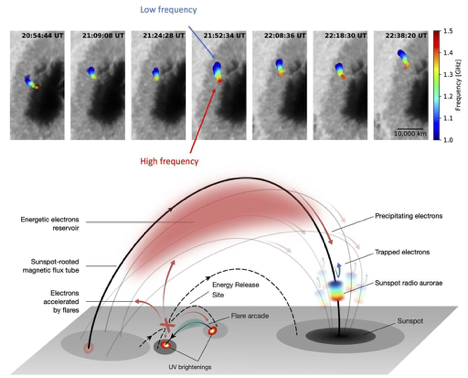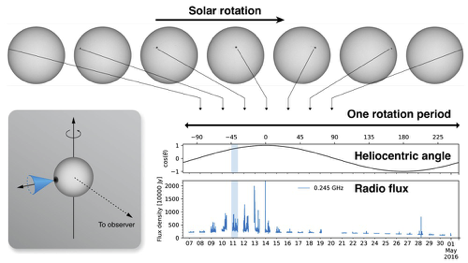Aurora-like Radio Emission from a Sunspot
From RHESSI Wiki
| Nugget | |
|---|---|
| Number: | 461 |
| 1st Author: | Sijie YU |
| 2nd Author: | |
| Published: | November 20, 2023 |
| Next Nugget: | TBD |
| Previous Nugget: | Search for a Flare Anticipation Index (FAI) |
| List all | |
Contents |
Introduction
The fascinating spectral of the aurora is often accompanied by a characteristic display of radio emissions, also a hallmark of the magnetospheres of several planets., These radio bursts are highly polarized and are typically attributed to electron cyclotron maser (ECM) emission, driven ("pumped") by non-Maxwellian velocity distributions in regions of converging magnetic fields (Ref. [1]). Notably, similar bursts have been observed in magnetically active low-mass stars and brown dwarfs, suggesting a universal mechanism underpinning these phenomena.
Electron Cyclotron Maser Emission from a Sunspot
A recent study (Ref. [2]) has used the Karl G. Jansky Very Large Array (VLA) to observe long-lasting solar radio bursts over a broad frequency range (1 to 1.7 GHz) from a bipolar sunspot group (Figure 1(a,b)). These bursts exhibited characteristics - strong circular polarization, high brightness temperature, and wide bandwidth - reminiscent of planetary auroral radio emissions and stellar ECM emissions. The emissions persisted for a week. VLA observed over a four-hour session during this long-lasting emission (Figure 1(c)). Intriguingly, the source of these emissions was located above a sunspot, where a strong and converging magnetic field is present. Distinct from another phenomenon, long-lasting polarized radio emission above sunspots has been observed for decades, the "type I" radio bursts, our reported emission clearly differs from these previously known bursts both spectrally and temporally.

Dynamic imaging spectroscopy with the VLA created images at hundreds of frequencies between 1 and 1.5 GHz at various times. The radio images, predominantly originating from a localized source near the sunspot, exhibited clear spatial dispersion across different frequencies. The frequency-dependent source centroid locations of each burst formed a near-linear dispersion in space, with the high-frequency ends oriented towards the sunspot. This rapid variation in the frequency-spatial dispersion and position angles of the bursts relative to the sunspot is illustrated in Figure 2 (upper panel).
The unique morphology and frequency dispersion in space are consistent with ECM emission, possibly driven by energetic electrons produced in nearby solar flares, as depicted in the bottom panel of Figure 2. This emission is interpreted as ECM emission induced by persistent energetic electrons trapped in large-scale magnetic loops anchored at the sunspot. The converging magnetic field above the sunspot forms a low-density cavity, conducive to ECM emission. This persistent radio emission suggests a continuous, albeit sporadic, operation of maser radiation, requiring frequent replenishment of energetic electrons to maintain the electron anisotropy in the radio source.
Solar-Stellar Connection
This discovery sheds new light on the origins of intense solar radio bursts and suggests fresh avenues for understanding similar phenomena in distant stars with pronounced starspots. A continuously replenished pool of energetic electrons, potentially due to stellar flaring activity, could be trapped above starspots, enabling ECM emissions even without a globally dipolar magnetic field. This mechanism could lead to sharply-beamed ECM emission above these starspots, resulting in auroral-like radio bursts that align with the rotational period of the host star (Figure 3), as seen in numerous cases of stellar ECM emissions.
This concept aligns with observations of periodic radio emissions from some stars, which coincide with their rotational cycles and have been historically interpreted as emanating from their polar regions. A starspot ECM emission model might therefore revise our current understanding of how stellar radio ECM emissions form, impacting theories about stellar internal dynamo mechanisms and the habitability of exoplanetary systems. Additionally, this model could explain the radio emissions from non-flaring, quiescent stars, which often deviate from the tight "G\"{u}del-Benz" radio-X-ray correlation typically observed in stellar emissions.
Summary
The detection of aurora-like radio emissions above a sunspot provides a novel perspective on solar and stellar magnetic activities. By studying such phenomena in our solar system, we can gain insights applicable to other star systems, particularly those with significant magnetic activity and starspots. This study opens avenues for further exploration into the mechanisms driving such emissions and their broader implications in astrophysics and exoplanetary research.
References
[1] "Electron-cyclotron masers as the source of certain solar and stellar radio bursts"
[2] "Detection of long-lasting aurora-like radio emission above a sunspot"
| RHESSI Nugget Date | 20 November 2023 + |
| RHESSI Nugget First Author | Sijie YU + |
| RHESSI Nugget Index | 461 + |

